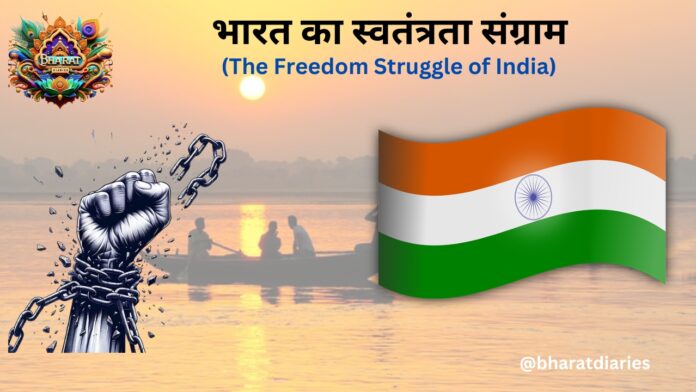
Explore India’s freedom struggle through its regional heroes: Bhagat Singh, Rani Lakshmibai, Subramania Bharati, and Netaji Subhas Chandra Bose. Discover their inspiring legacies.
Table of Contents
India’s freedom struggle is a story of unparalleled courage, sacrifice, and resilience. From the north to the south, and from the east to the west, heroes emerged, each contributing uniquely to overthrow colonial rule. The contributions of iconic leaders like Bhagat Singh, Rani Lakshmibai, Subramania Bharati, Netaji Subhas Chandra Bose, and others form an intricate tapestry of this fight for independence.
In this blog, we delve into the lives and efforts of these freedom fighters, showcasing how their regional identities united into a national mission. Whether through armed revolts, reformist ideas, or literary inspiration, their contributions have left an indelible mark on India’s history.
The Northern Torchbearers: Bhagat Singh and Rani Lakshmibai
Bhagat Singh: The Revolutionary Icon
Bhagat Singh, born in 1907 in Punjab, became synonymous with youthful rebellion against British rule. A staunch believer in socialism, Bhagat Singh’s fearless activism aimed to awaken the masses. His significant contributions include:
- Lahore Conspiracy Case (1929): Bhagat Singh and Batukeshwar Dutt threw bombs in the Central Legislative Assembly to protest oppressive laws, ensuring no harm but creating maximum impact.
- Martyrdom (1931): His execution at the young age of 23 galvanized the youth of India and turned him into an enduring symbol of sacrifice.
- Literary Legacy: Bhagat Singh’s essays and letters continue to inspire discussions on justice, equality, and liberty.
https://bharatdiaries.com/exploring-the-rich-heritage-of-indian-culture/
Rani Lakshmibai: The Warrior Queen
Known as the “Queen of Jhansi,” Rani Lakshmibai epitomized bravery during the Revolt of 1857. Key highlights of her contributions include:
- Leading the 1857 Uprising: Defying British annexation policies, she led her army with unmatched valor, famously proclaiming, “I shall not surrender my Jhansi.”
- Battle of Gwalior: Despite facing betrayal, Rani Lakshmibai fought fiercely, sacrificing her life for her kingdom and people.
- Legacy of Resistance: She remains a powerful symbol of women’s empowerment and patriotism.
The Southern Crusaders: Velu Nachiyar and Subramania Bharati
Velu Nachiyar: The First Queen to Wage War Against the British
Velu Nachiyar, the Queen of Sivaganga (Tamil Nadu), was among the earliest monarchs to challenge British dominance. Her achievements include:
- Military Alliance with Hyder Ali: She sought assistance to regain her kingdom, showcasing diplomatic acumen.
- Revolutionary Warfare: Velu Nachiyar is credited with the first recorded instance of a suicide bombing tactic in India’s freedom movement.
- Inspiring Leadership: She led her troops fearlessly, setting the stage for future resistance movements in the south.
Subramania Bharati: The Poet of Freedom
Subramania Bharati, a Tamil poet and journalist, wielded his pen as a weapon against British rule. His contributions include:
- Revolutionary Literature: Bharati’s poems like “Viduthalai” (Freedom) and “Achamillai” (Fearlessness) ignited the spirit of independence.
- Advocacy for Social Reforms: He championed women’s rights, caste equality, and education, emphasizing that true freedom must encompass societal transformation.
- Journalistic Activism: Through publications like India and Swadesamitran, Bharati mobilized public opinion against colonial oppression.
The Eastern Visionaries: Netaji Subhas Chandra Bose and Khudiram Bose
Netaji Subhas Chandra Bose: The Leader of the Indian National Army
Netaji Subhas Chandra Bose’s defiance of British authority made him a towering figure in India’s struggle for independence. His key contributions include:
- Formation of INA: Bose revived the Indian National Army (INA) to wage an armed struggle against British rule.
- Azad Hind Government: He established a provisional government-in-exile, emphasizing India’s sovereignty.
- Inspiring Slogan: “Give me blood, and I shall give you freedom” remains etched in the collective memory of Indians.
Khudiram Bose: The Teenage Martyr
Khudiram Bose, one of the youngest martyrs of India’s freedom struggle, left a lasting legacy of courage.
- Muzaffarpur Conspiracy (1908): At just 18, Khudiram attempted to assassinate a British magistrate, showcasing remarkable bravery.
- Martyrdom: His execution sparked widespread outrage, inspiring countless others to join the freedom movement.
The Western Pioneers: Bal Gangadhar Tilak
Bal Gangadhar Tilak: The Father of Indian Unrest
Tilak, a leader of the Indian nationalist movement, laid the foundation for Swaraj (self-rule). His major contributions include:
- Home Rule Movement: Tilak’s demand for Swaraj as a birthright resonated across the nation.
- Reformist Writings: Through Kesari and Maratha, he articulated the aspirations of the common people.
- Ganpati and Shivaji Festivals: By organizing public celebrations, Tilak united communities and fostered a sense of collective identity.
Conclusion
India’s freedom struggle is a testament to the diversity and unity of its people. From Bhagat Singh’s revolutionary fervor to Subramania Bharati’s poetic inspiration, each hero contributed uniquely to the larger cause of independence. Their legacies continue to inspire us to cherish and uphold the hard-earned freedom of our nation.
